Taxation Law Issues Question and Answer 2022
VerifiedAdded on 2022/09/28
|12
|3172
|22
AI Summary
Contribute Materials
Your contribution can guide someone’s learning journey. Share your
documents today.
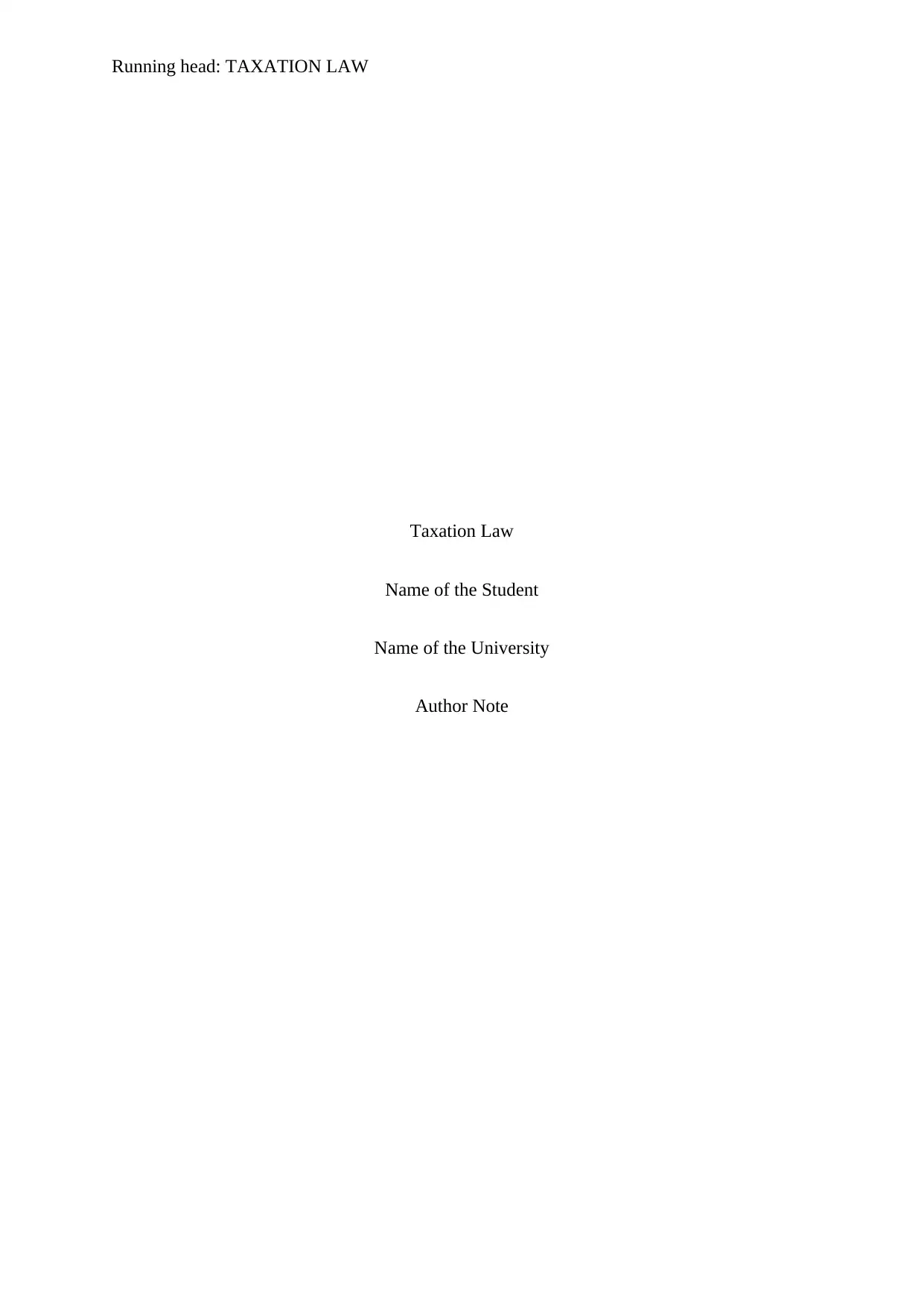
Running head: TAXATION LAW
Taxation Law
Name of the Student
Name of the University
Author Note
Taxation Law
Name of the Student
Name of the University
Author Note
Secure Best Marks with AI Grader
Need help grading? Try our AI Grader for instant feedback on your assignments.
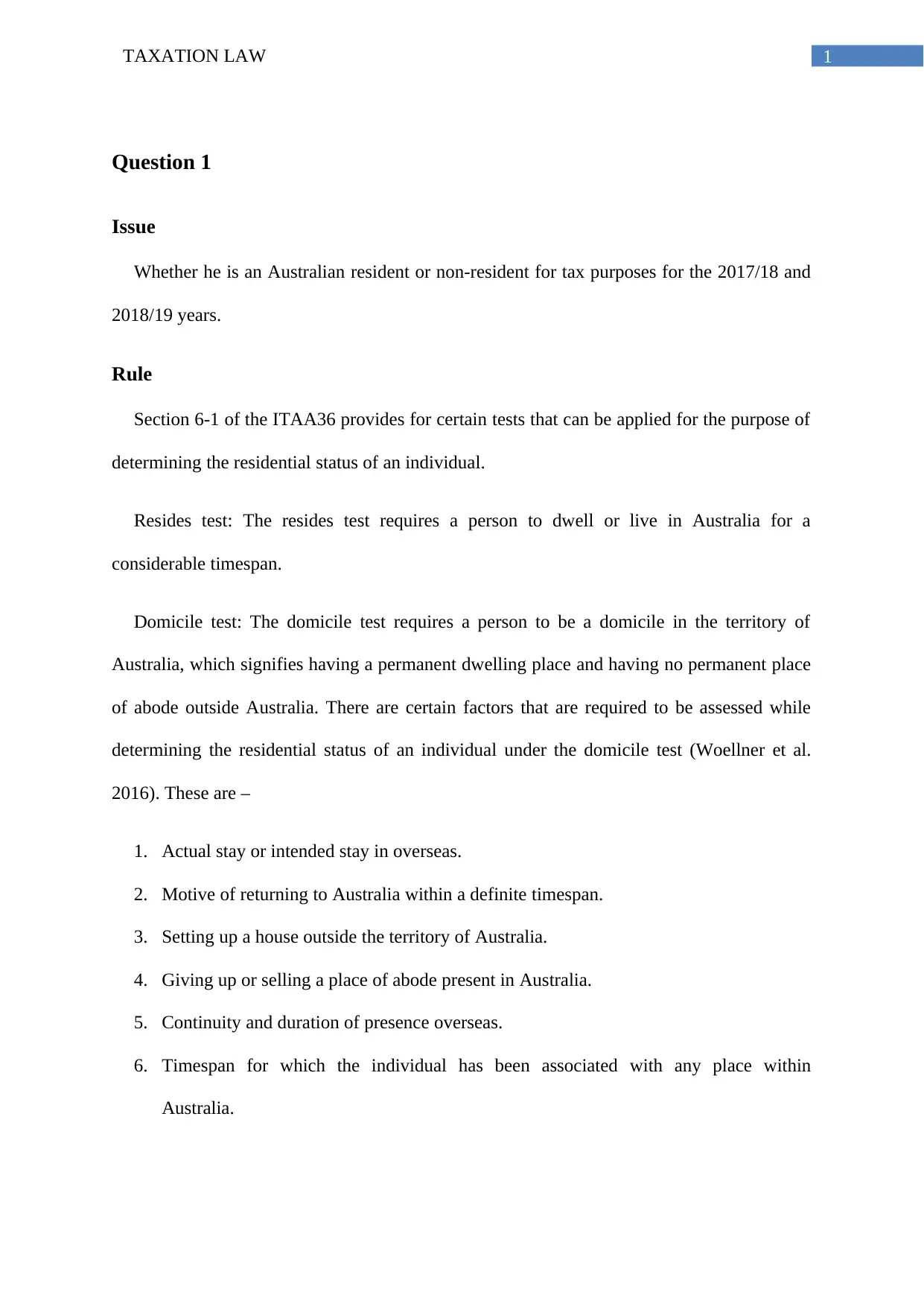
1TAXATION LAW
Question 1
Issue
Whether he is an Australian resident or non-resident for tax purposes for the 2017/18 and
2018/19 years.
Rule
Section 6-1 of the ITAA36 provides for certain tests that can be applied for the purpose of
determining the residential status of an individual.
Resides test: The resides test requires a person to dwell or live in Australia for a
considerable timespan.
Domicile test: The domicile test requires a person to be a domicile in the territory of
Australia, which signifies having a permanent dwelling place and having no permanent place
of abode outside Australia. There are certain factors that are required to be assessed while
determining the residential status of an individual under the domicile test (Woellner et al.
2016). These are –
1. Actual stay or intended stay in overseas.
2. Motive of returning to Australia within a definite timespan.
3. Setting up a house outside the territory of Australia.
4. Giving up or selling a place of abode present in Australia.
5. Continuity and duration of presence overseas.
6. Timespan for which the individual has been associated with any place within
Australia.
Question 1
Issue
Whether he is an Australian resident or non-resident for tax purposes for the 2017/18 and
2018/19 years.
Rule
Section 6-1 of the ITAA36 provides for certain tests that can be applied for the purpose of
determining the residential status of an individual.
Resides test: The resides test requires a person to dwell or live in Australia for a
considerable timespan.
Domicile test: The domicile test requires a person to be a domicile in the territory of
Australia, which signifies having a permanent dwelling place and having no permanent place
of abode outside Australia. There are certain factors that are required to be assessed while
determining the residential status of an individual under the domicile test (Woellner et al.
2016). These are –
1. Actual stay or intended stay in overseas.
2. Motive of returning to Australia within a definite timespan.
3. Setting up a house outside the territory of Australia.
4. Giving up or selling a place of abode present in Australia.
5. Continuity and duration of presence overseas.
6. Timespan for which the individual has been associated with any place within
Australia.
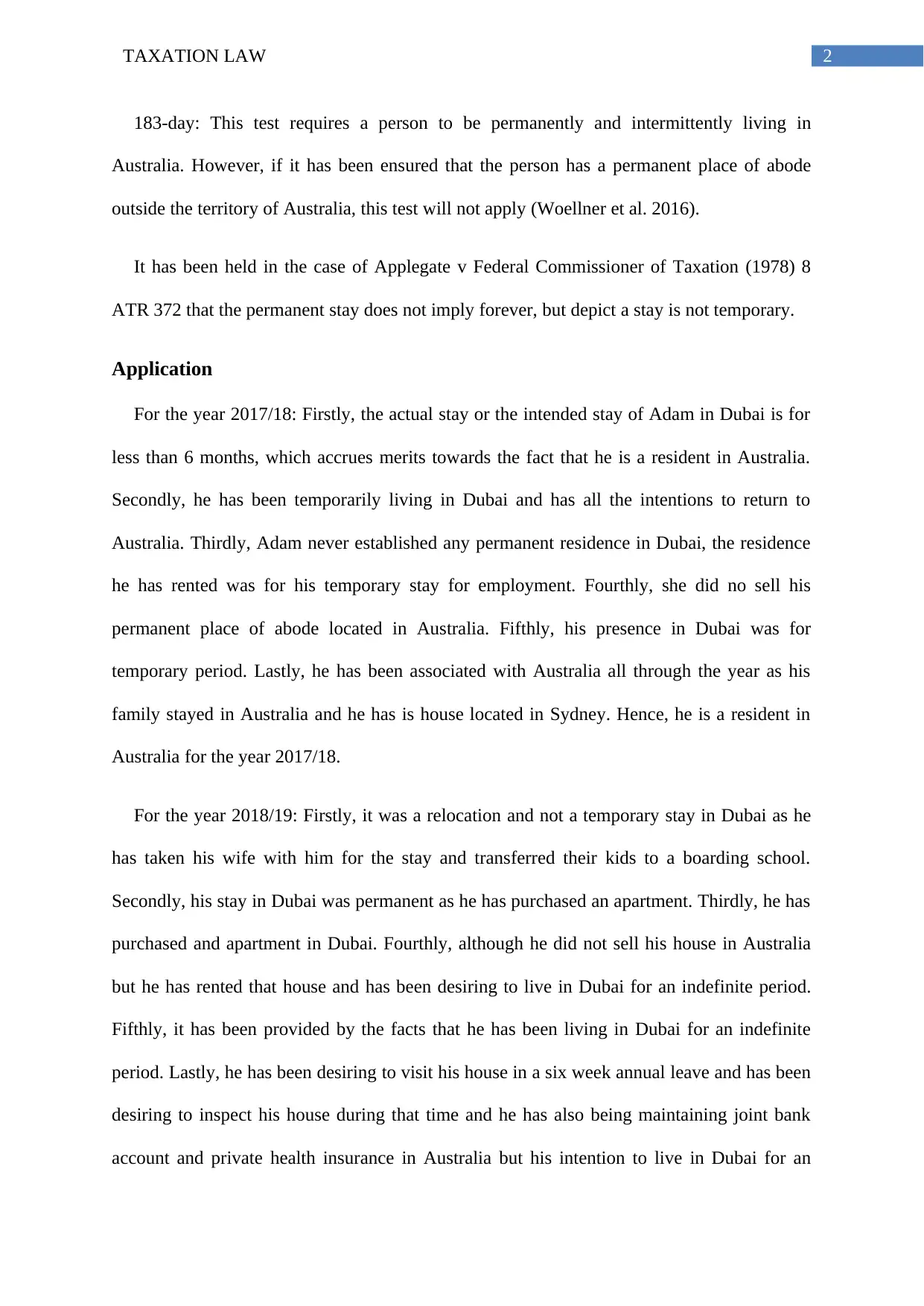
2TAXATION LAW
183-day: This test requires a person to be permanently and intermittently living in
Australia. However, if it has been ensured that the person has a permanent place of abode
outside the territory of Australia, this test will not apply (Woellner et al. 2016).
It has been held in the case of Applegate v Federal Commissioner of Taxation (1978) 8
ATR 372 that the permanent stay does not imply forever, but depict a stay is not temporary.
Application
For the year 2017/18: Firstly, the actual stay or the intended stay of Adam in Dubai is for
less than 6 months, which accrues merits towards the fact that he is a resident in Australia.
Secondly, he has been temporarily living in Dubai and has all the intentions to return to
Australia. Thirdly, Adam never established any permanent residence in Dubai, the residence
he has rented was for his temporary stay for employment. Fourthly, she did no sell his
permanent place of abode located in Australia. Fifthly, his presence in Dubai was for
temporary period. Lastly, he has been associated with Australia all through the year as his
family stayed in Australia and he has is house located in Sydney. Hence, he is a resident in
Australia for the year 2017/18.
For the year 2018/19: Firstly, it was a relocation and not a temporary stay in Dubai as he
has taken his wife with him for the stay and transferred their kids to a boarding school.
Secondly, his stay in Dubai was permanent as he has purchased an apartment. Thirdly, he has
purchased and apartment in Dubai. Fourthly, although he did not sell his house in Australia
but he has rented that house and has been desiring to live in Dubai for an indefinite period.
Fifthly, it has been provided by the facts that he has been living in Dubai for an indefinite
period. Lastly, he has been desiring to visit his house in a six week annual leave and has been
desiring to inspect his house during that time and he has also being maintaining joint bank
account and private health insurance in Australia but his intention to live in Dubai for an
183-day: This test requires a person to be permanently and intermittently living in
Australia. However, if it has been ensured that the person has a permanent place of abode
outside the territory of Australia, this test will not apply (Woellner et al. 2016).
It has been held in the case of Applegate v Federal Commissioner of Taxation (1978) 8
ATR 372 that the permanent stay does not imply forever, but depict a stay is not temporary.
Application
For the year 2017/18: Firstly, the actual stay or the intended stay of Adam in Dubai is for
less than 6 months, which accrues merits towards the fact that he is a resident in Australia.
Secondly, he has been temporarily living in Dubai and has all the intentions to return to
Australia. Thirdly, Adam never established any permanent residence in Dubai, the residence
he has rented was for his temporary stay for employment. Fourthly, she did no sell his
permanent place of abode located in Australia. Fifthly, his presence in Dubai was for
temporary period. Lastly, he has been associated with Australia all through the year as his
family stayed in Australia and he has is house located in Sydney. Hence, he is a resident in
Australia for the year 2017/18.
For the year 2018/19: Firstly, it was a relocation and not a temporary stay in Dubai as he
has taken his wife with him for the stay and transferred their kids to a boarding school.
Secondly, his stay in Dubai was permanent as he has purchased an apartment. Thirdly, he has
purchased and apartment in Dubai. Fourthly, although he did not sell his house in Australia
but he has rented that house and has been desiring to live in Dubai for an indefinite period.
Fifthly, it has been provided by the facts that he has been living in Dubai for an indefinite
period. Lastly, he has been desiring to visit his house in a six week annual leave and has been
desiring to inspect his house during that time and he has also being maintaining joint bank
account and private health insurance in Australia but his intention to live in Dubai for an
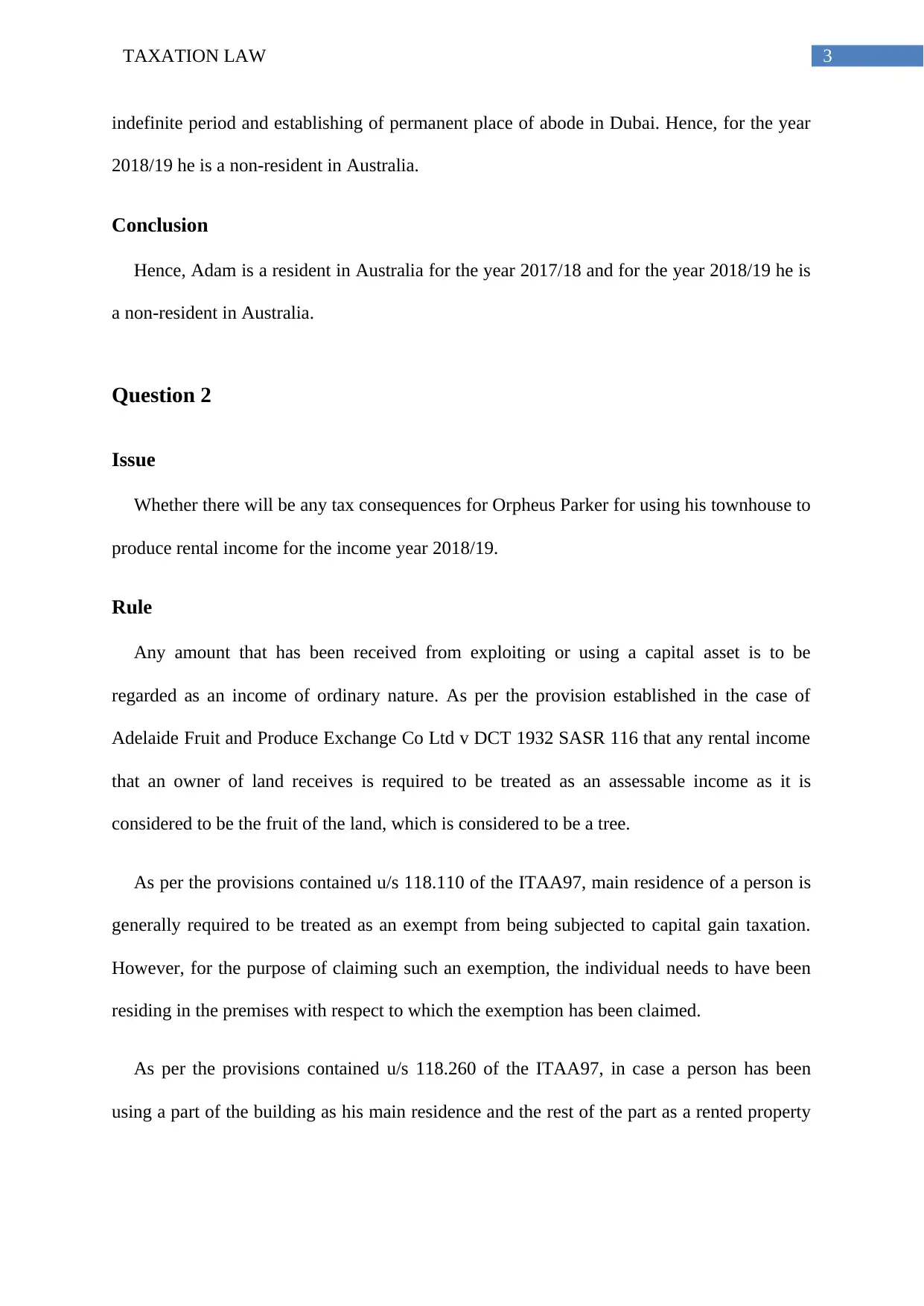
3TAXATION LAW
indefinite period and establishing of permanent place of abode in Dubai. Hence, for the year
2018/19 he is a non-resident in Australia.
Conclusion
Hence, Adam is a resident in Australia for the year 2017/18 and for the year 2018/19 he is
a non-resident in Australia.
Question 2
Issue
Whether there will be any tax consequences for Orpheus Parker for using his townhouse to
produce rental income for the income year 2018/19.
Rule
Any amount that has been received from exploiting or using a capital asset is to be
regarded as an income of ordinary nature. As per the provision established in the case of
Adelaide Fruit and Produce Exchange Co Ltd v DCT 1932 SASR 116 that any rental income
that an owner of land receives is required to be treated as an assessable income as it is
considered to be the fruit of the land, which is considered to be a tree.
As per the provisions contained u/s 118.110 of the ITAA97, main residence of a person is
generally required to be treated as an exempt from being subjected to capital gain taxation.
However, for the purpose of claiming such an exemption, the individual needs to have been
residing in the premises with respect to which the exemption has been claimed.
As per the provisions contained u/s 118.260 of the ITAA97, in case a person has been
using a part of the building as his main residence and the rest of the part as a rented property
indefinite period and establishing of permanent place of abode in Dubai. Hence, for the year
2018/19 he is a non-resident in Australia.
Conclusion
Hence, Adam is a resident in Australia for the year 2017/18 and for the year 2018/19 he is
a non-resident in Australia.
Question 2
Issue
Whether there will be any tax consequences for Orpheus Parker for using his townhouse to
produce rental income for the income year 2018/19.
Rule
Any amount that has been received from exploiting or using a capital asset is to be
regarded as an income of ordinary nature. As per the provision established in the case of
Adelaide Fruit and Produce Exchange Co Ltd v DCT 1932 SASR 116 that any rental income
that an owner of land receives is required to be treated as an assessable income as it is
considered to be the fruit of the land, which is considered to be a tree.
As per the provisions contained u/s 118.110 of the ITAA97, main residence of a person is
generally required to be treated as an exempt from being subjected to capital gain taxation.
However, for the purpose of claiming such an exemption, the individual needs to have been
residing in the premises with respect to which the exemption has been claimed.
As per the provisions contained u/s 118.260 of the ITAA97, in case a person has been
using a part of the building as his main residence and the rest of the part as a rented property
Secure Best Marks with AI Grader
Need help grading? Try our AI Grader for instant feedback on your assignments.
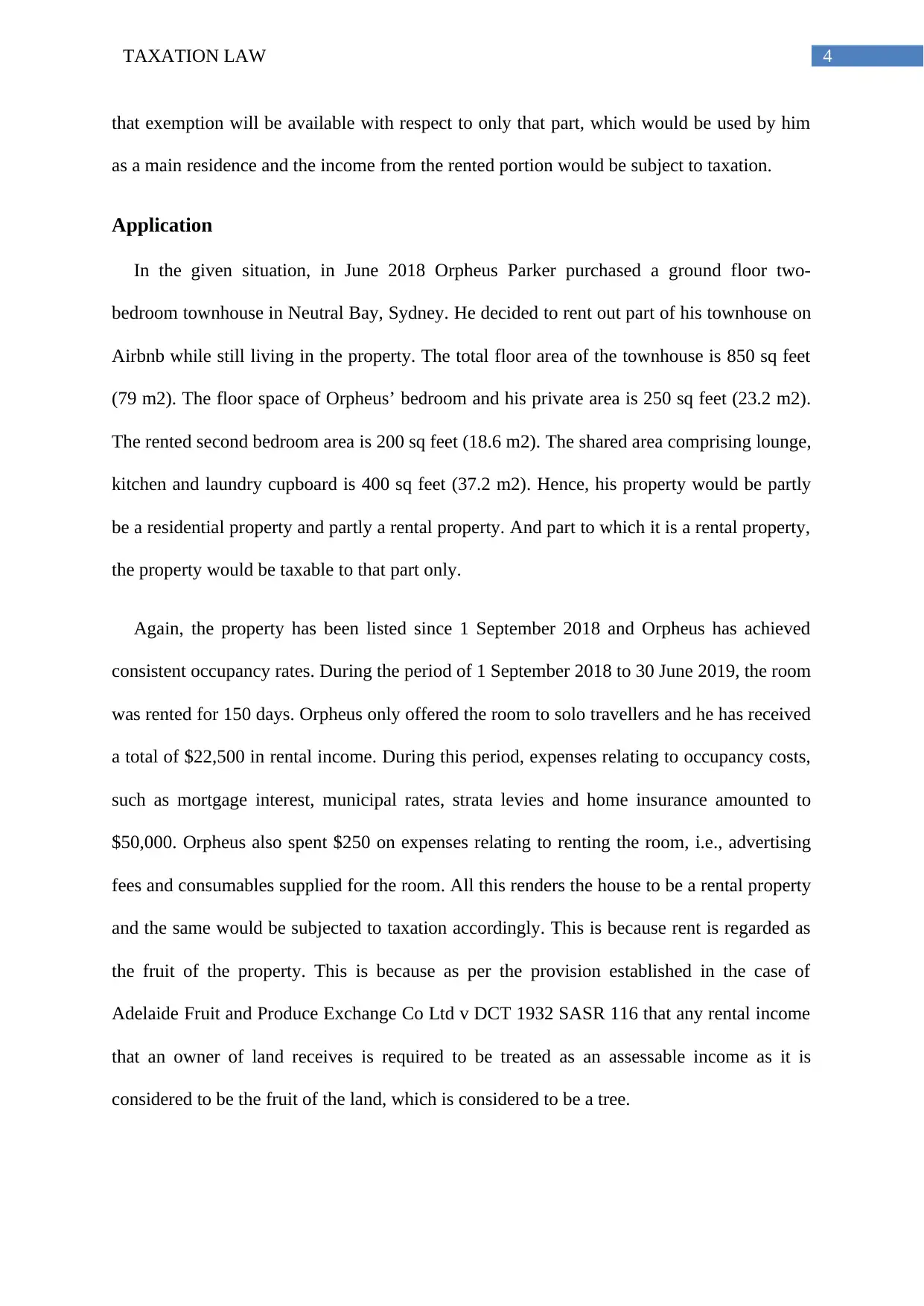
4TAXATION LAW
that exemption will be available with respect to only that part, which would be used by him
as a main residence and the income from the rented portion would be subject to taxation.
Application
In the given situation, in June 2018 Orpheus Parker purchased a ground floor two-
bedroom townhouse in Neutral Bay, Sydney. He decided to rent out part of his townhouse on
Airbnb while still living in the property. The total floor area of the townhouse is 850 sq feet
(79 m2). The floor space of Orpheus’ bedroom and his private area is 250 sq feet (23.2 m2).
The rented second bedroom area is 200 sq feet (18.6 m2). The shared area comprising lounge,
kitchen and laundry cupboard is 400 sq feet (37.2 m2). Hence, his property would be partly
be a residential property and partly a rental property. And part to which it is a rental property,
the property would be taxable to that part only.
Again, the property has been listed since 1 September 2018 and Orpheus has achieved
consistent occupancy rates. During the period of 1 September 2018 to 30 June 2019, the room
was rented for 150 days. Orpheus only offered the room to solo travellers and he has received
a total of $22,500 in rental income. During this period, expenses relating to occupancy costs,
such as mortgage interest, municipal rates, strata levies and home insurance amounted to
$50,000. Orpheus also spent $250 on expenses relating to renting the room, i.e., advertising
fees and consumables supplied for the room. All this renders the house to be a rental property
and the same would be subjected to taxation accordingly. This is because rent is regarded as
the fruit of the property. This is because as per the provision established in the case of
Adelaide Fruit and Produce Exchange Co Ltd v DCT 1932 SASR 116 that any rental income
that an owner of land receives is required to be treated as an assessable income as it is
considered to be the fruit of the land, which is considered to be a tree.
that exemption will be available with respect to only that part, which would be used by him
as a main residence and the income from the rented portion would be subject to taxation.
Application
In the given situation, in June 2018 Orpheus Parker purchased a ground floor two-
bedroom townhouse in Neutral Bay, Sydney. He decided to rent out part of his townhouse on
Airbnb while still living in the property. The total floor area of the townhouse is 850 sq feet
(79 m2). The floor space of Orpheus’ bedroom and his private area is 250 sq feet (23.2 m2).
The rented second bedroom area is 200 sq feet (18.6 m2). The shared area comprising lounge,
kitchen and laundry cupboard is 400 sq feet (37.2 m2). Hence, his property would be partly
be a residential property and partly a rental property. And part to which it is a rental property,
the property would be taxable to that part only.
Again, the property has been listed since 1 September 2018 and Orpheus has achieved
consistent occupancy rates. During the period of 1 September 2018 to 30 June 2019, the room
was rented for 150 days. Orpheus only offered the room to solo travellers and he has received
a total of $22,500 in rental income. During this period, expenses relating to occupancy costs,
such as mortgage interest, municipal rates, strata levies and home insurance amounted to
$50,000. Orpheus also spent $250 on expenses relating to renting the room, i.e., advertising
fees and consumables supplied for the room. All this renders the house to be a rental property
and the same would be subjected to taxation accordingly. This is because rent is regarded as
the fruit of the property. This is because as per the provision established in the case of
Adelaide Fruit and Produce Exchange Co Ltd v DCT 1932 SASR 116 that any rental income
that an owner of land receives is required to be treated as an assessable income as it is
considered to be the fruit of the land, which is considered to be a tree.
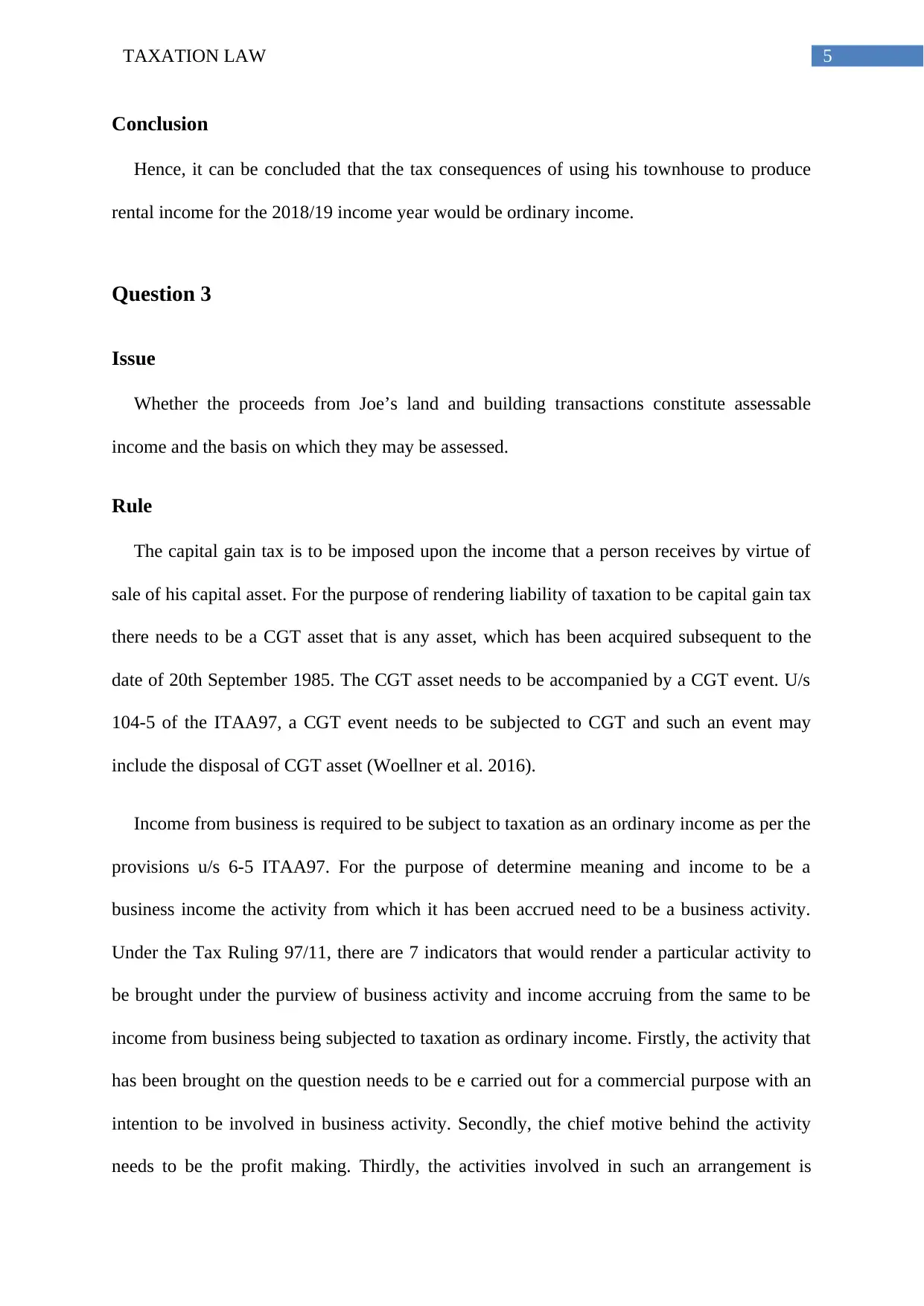
5TAXATION LAW
Conclusion
Hence, it can be concluded that the tax consequences of using his townhouse to produce
rental income for the 2018/19 income year would be ordinary income.
Question 3
Issue
Whether the proceeds from Joe’s land and building transactions constitute assessable
income and the basis on which they may be assessed.
Rule
The capital gain tax is to be imposed upon the income that a person receives by virtue of
sale of his capital asset. For the purpose of rendering liability of taxation to be capital gain tax
there needs to be a CGT asset that is any asset, which has been acquired subsequent to the
date of 20th September 1985. The CGT asset needs to be accompanied by a CGT event. U/s
104-5 of the ITAA97, a CGT event needs to be subjected to CGT and such an event may
include the disposal of CGT asset (Woellner et al. 2016).
Income from business is required to be subject to taxation as an ordinary income as per the
provisions u/s 6-5 ITAA97. For the purpose of determine meaning and income to be a
business income the activity from which it has been accrued need to be a business activity.
Under the Tax Ruling 97/11, there are 7 indicators that would render a particular activity to
be brought under the purview of business activity and income accruing from the same to be
income from business being subjected to taxation as ordinary income. Firstly, the activity that
has been brought on the question needs to be e carried out for a commercial purpose with an
intention to be involved in business activity. Secondly, the chief motive behind the activity
needs to be the profit making. Thirdly, the activities involved in such an arrangement is
Conclusion
Hence, it can be concluded that the tax consequences of using his townhouse to produce
rental income for the 2018/19 income year would be ordinary income.
Question 3
Issue
Whether the proceeds from Joe’s land and building transactions constitute assessable
income and the basis on which they may be assessed.
Rule
The capital gain tax is to be imposed upon the income that a person receives by virtue of
sale of his capital asset. For the purpose of rendering liability of taxation to be capital gain tax
there needs to be a CGT asset that is any asset, which has been acquired subsequent to the
date of 20th September 1985. The CGT asset needs to be accompanied by a CGT event. U/s
104-5 of the ITAA97, a CGT event needs to be subjected to CGT and such an event may
include the disposal of CGT asset (Woellner et al. 2016).
Income from business is required to be subject to taxation as an ordinary income as per the
provisions u/s 6-5 ITAA97. For the purpose of determine meaning and income to be a
business income the activity from which it has been accrued need to be a business activity.
Under the Tax Ruling 97/11, there are 7 indicators that would render a particular activity to
be brought under the purview of business activity and income accruing from the same to be
income from business being subjected to taxation as ordinary income. Firstly, the activity that
has been brought on the question needs to be e carried out for a commercial purpose with an
intention to be involved in business activity. Secondly, the chief motive behind the activity
needs to be the profit making. Thirdly, the activities involved in such an arrangement is
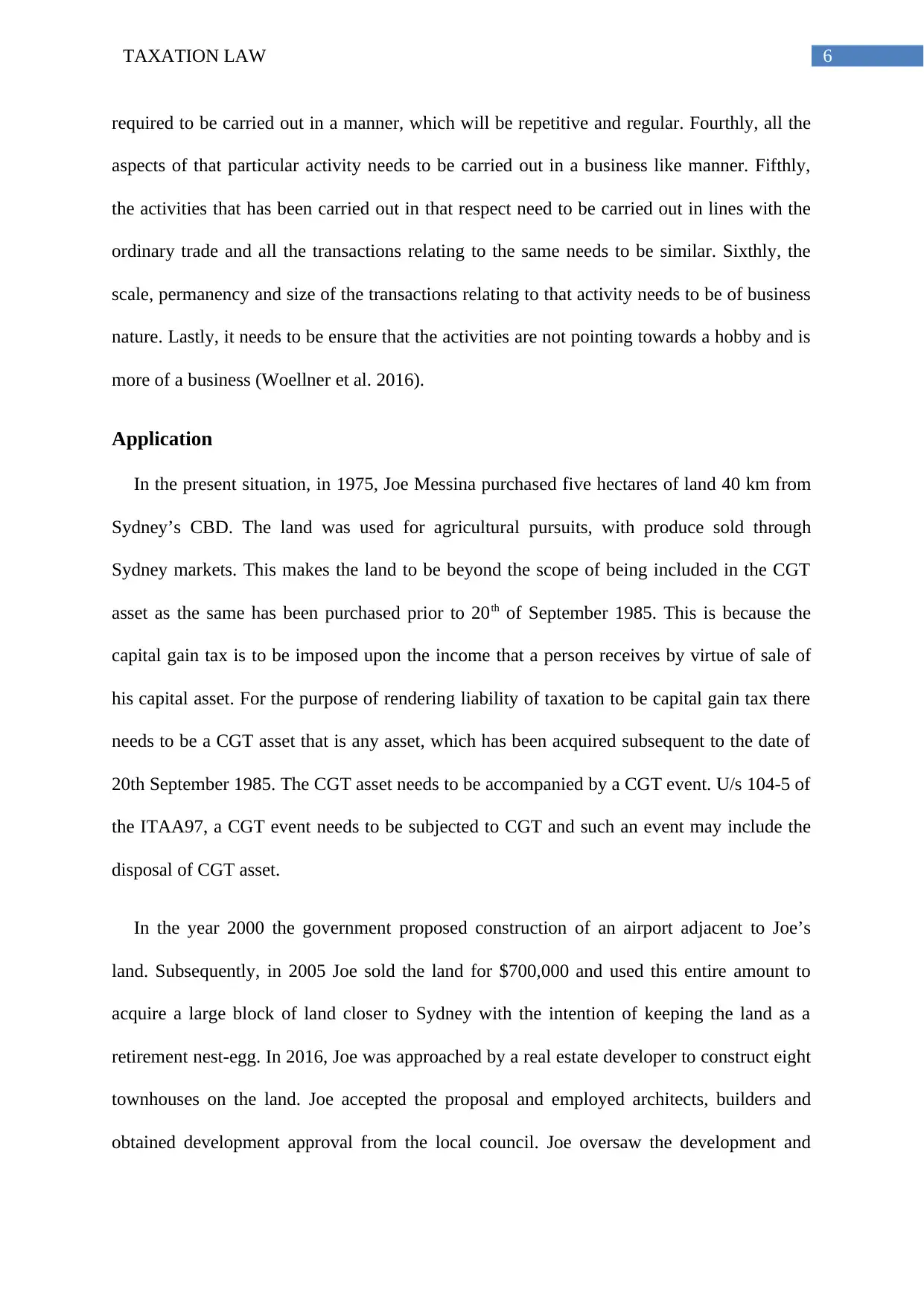
6TAXATION LAW
required to be carried out in a manner, which will be repetitive and regular. Fourthly, all the
aspects of that particular activity needs to be carried out in a business like manner. Fifthly,
the activities that has been carried out in that respect need to be carried out in lines with the
ordinary trade and all the transactions relating to the same needs to be similar. Sixthly, the
scale, permanency and size of the transactions relating to that activity needs to be of business
nature. Lastly, it needs to be ensure that the activities are not pointing towards a hobby and is
more of a business (Woellner et al. 2016).
Application
In the present situation, in 1975, Joe Messina purchased five hectares of land 40 km from
Sydney’s CBD. The land was used for agricultural pursuits, with produce sold through
Sydney markets. This makes the land to be beyond the scope of being included in the CGT
asset as the same has been purchased prior to 20th of September 1985. This is because the
capital gain tax is to be imposed upon the income that a person receives by virtue of sale of
his capital asset. For the purpose of rendering liability of taxation to be capital gain tax there
needs to be a CGT asset that is any asset, which has been acquired subsequent to the date of
20th September 1985. The CGT asset needs to be accompanied by a CGT event. U/s 104-5 of
the ITAA97, a CGT event needs to be subjected to CGT and such an event may include the
disposal of CGT asset.
In the year 2000 the government proposed construction of an airport adjacent to Joe’s
land. Subsequently, in 2005 Joe sold the land for $700,000 and used this entire amount to
acquire a large block of land closer to Sydney with the intention of keeping the land as a
retirement nest-egg. In 2016, Joe was approached by a real estate developer to construct eight
townhouses on the land. Joe accepted the proposal and employed architects, builders and
obtained development approval from the local council. Joe oversaw the development and
required to be carried out in a manner, which will be repetitive and regular. Fourthly, all the
aspects of that particular activity needs to be carried out in a business like manner. Fifthly,
the activities that has been carried out in that respect need to be carried out in lines with the
ordinary trade and all the transactions relating to the same needs to be similar. Sixthly, the
scale, permanency and size of the transactions relating to that activity needs to be of business
nature. Lastly, it needs to be ensure that the activities are not pointing towards a hobby and is
more of a business (Woellner et al. 2016).
Application
In the present situation, in 1975, Joe Messina purchased five hectares of land 40 km from
Sydney’s CBD. The land was used for agricultural pursuits, with produce sold through
Sydney markets. This makes the land to be beyond the scope of being included in the CGT
asset as the same has been purchased prior to 20th of September 1985. This is because the
capital gain tax is to be imposed upon the income that a person receives by virtue of sale of
his capital asset. For the purpose of rendering liability of taxation to be capital gain tax there
needs to be a CGT asset that is any asset, which has been acquired subsequent to the date of
20th September 1985. The CGT asset needs to be accompanied by a CGT event. U/s 104-5 of
the ITAA97, a CGT event needs to be subjected to CGT and such an event may include the
disposal of CGT asset.
In the year 2000 the government proposed construction of an airport adjacent to Joe’s
land. Subsequently, in 2005 Joe sold the land for $700,000 and used this entire amount to
acquire a large block of land closer to Sydney with the intention of keeping the land as a
retirement nest-egg. In 2016, Joe was approached by a real estate developer to construct eight
townhouses on the land. Joe accepted the proposal and employed architects, builders and
obtained development approval from the local council. Joe oversaw the development and
Paraphrase This Document
Need a fresh take? Get an instant paraphrase of this document with our AI Paraphraser
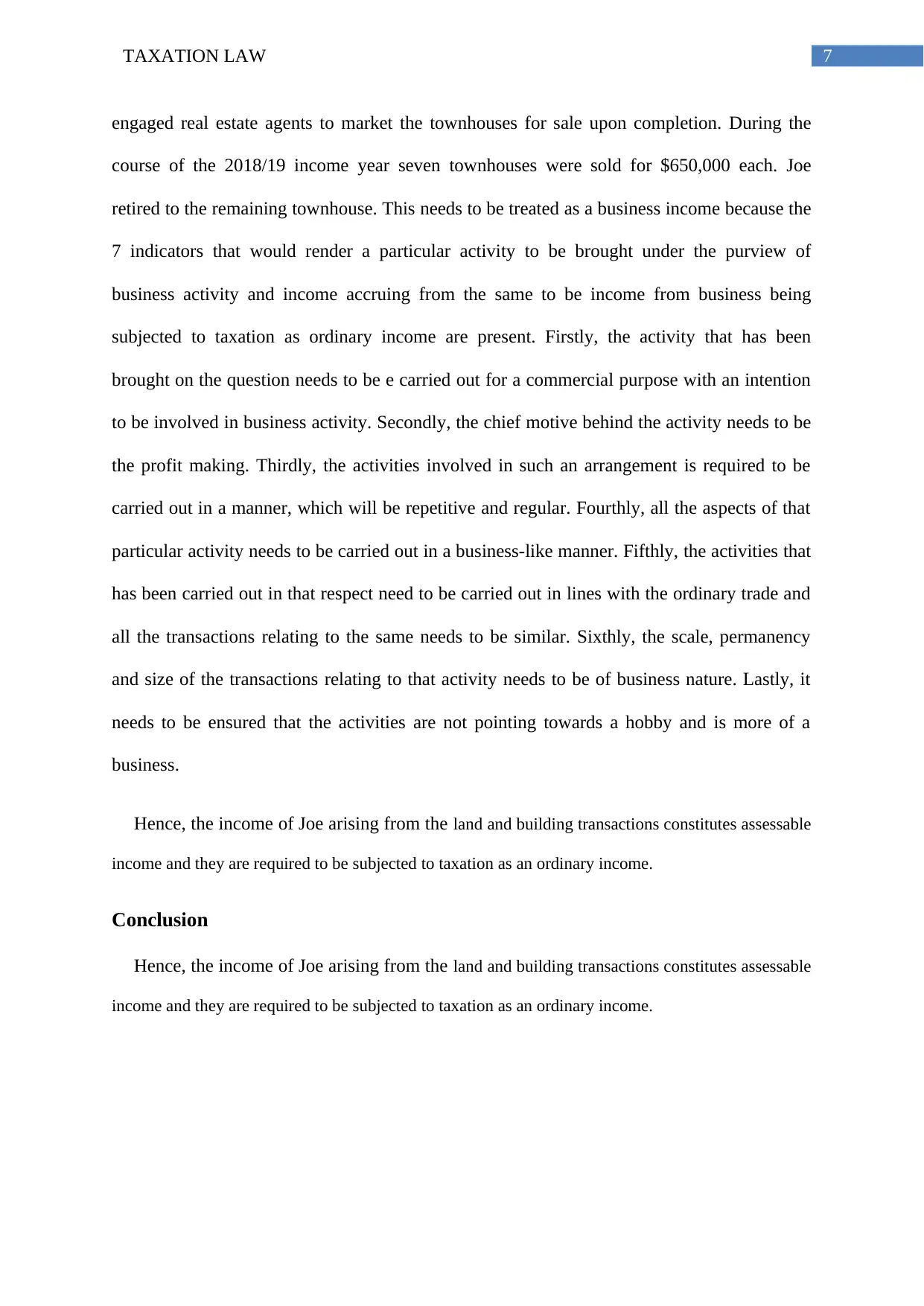
7TAXATION LAW
engaged real estate agents to market the townhouses for sale upon completion. During the
course of the 2018/19 income year seven townhouses were sold for $650,000 each. Joe
retired to the remaining townhouse. This needs to be treated as a business income because the
7 indicators that would render a particular activity to be brought under the purview of
business activity and income accruing from the same to be income from business being
subjected to taxation as ordinary income are present. Firstly, the activity that has been
brought on the question needs to be e carried out for a commercial purpose with an intention
to be involved in business activity. Secondly, the chief motive behind the activity needs to be
the profit making. Thirdly, the activities involved in such an arrangement is required to be
carried out in a manner, which will be repetitive and regular. Fourthly, all the aspects of that
particular activity needs to be carried out in a business-like manner. Fifthly, the activities that
has been carried out in that respect need to be carried out in lines with the ordinary trade and
all the transactions relating to the same needs to be similar. Sixthly, the scale, permanency
and size of the transactions relating to that activity needs to be of business nature. Lastly, it
needs to be ensured that the activities are not pointing towards a hobby and is more of a
business.
Hence, the income of Joe arising from the land and building transactions constitutes assessable
income and they are required to be subjected to taxation as an ordinary income.
Conclusion
Hence, the income of Joe arising from the land and building transactions constitutes assessable
income and they are required to be subjected to taxation as an ordinary income.
engaged real estate agents to market the townhouses for sale upon completion. During the
course of the 2018/19 income year seven townhouses were sold for $650,000 each. Joe
retired to the remaining townhouse. This needs to be treated as a business income because the
7 indicators that would render a particular activity to be brought under the purview of
business activity and income accruing from the same to be income from business being
subjected to taxation as ordinary income are present. Firstly, the activity that has been
brought on the question needs to be e carried out for a commercial purpose with an intention
to be involved in business activity. Secondly, the chief motive behind the activity needs to be
the profit making. Thirdly, the activities involved in such an arrangement is required to be
carried out in a manner, which will be repetitive and regular. Fourthly, all the aspects of that
particular activity needs to be carried out in a business-like manner. Fifthly, the activities that
has been carried out in that respect need to be carried out in lines with the ordinary trade and
all the transactions relating to the same needs to be similar. Sixthly, the scale, permanency
and size of the transactions relating to that activity needs to be of business nature. Lastly, it
needs to be ensured that the activities are not pointing towards a hobby and is more of a
business.
Hence, the income of Joe arising from the land and building transactions constitutes assessable
income and they are required to be subjected to taxation as an ordinary income.
Conclusion
Hence, the income of Joe arising from the land and building transactions constitutes assessable
income and they are required to be subjected to taxation as an ordinary income.
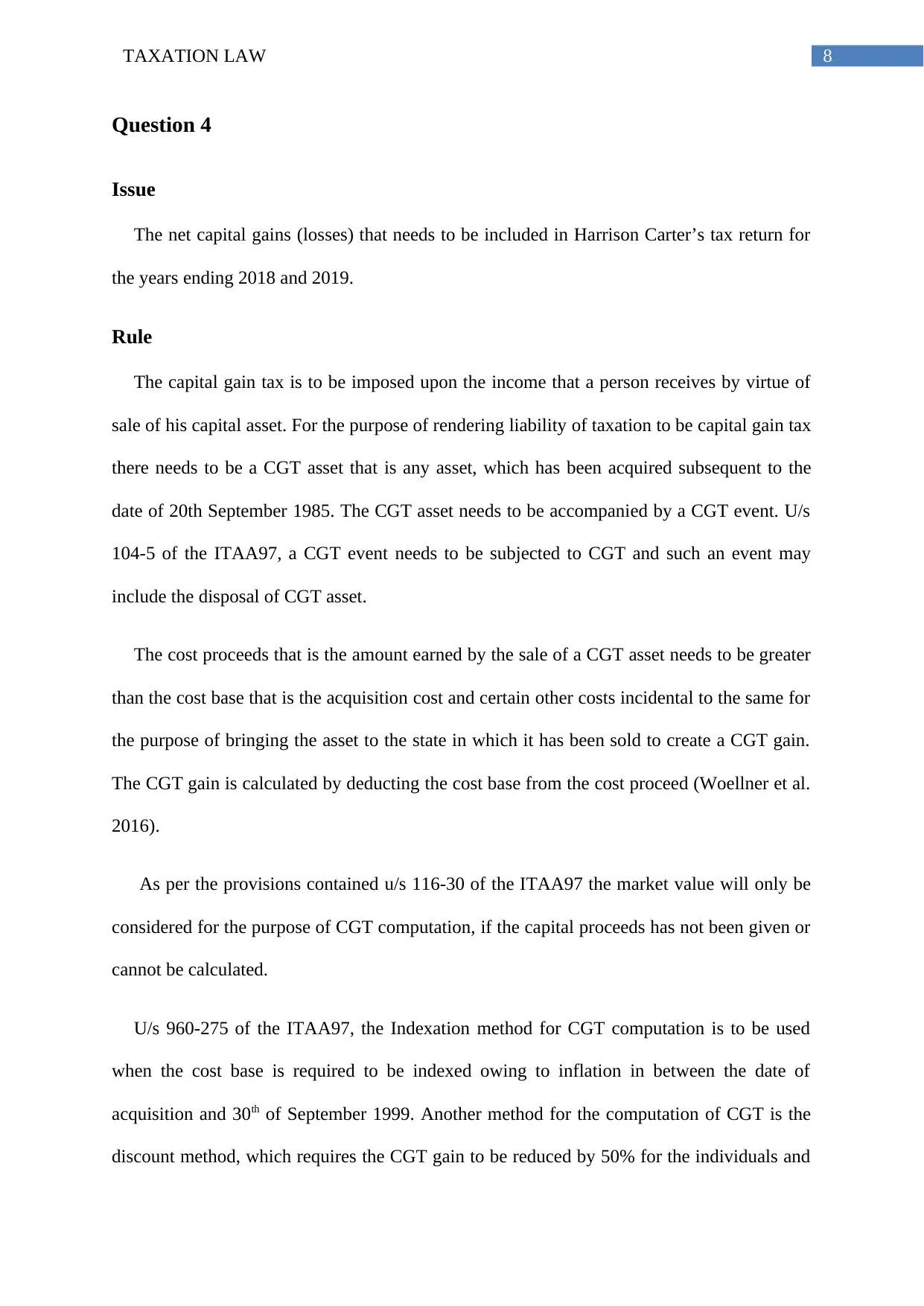
8TAXATION LAW
Question 4
Issue
The net capital gains (losses) that needs to be included in Harrison Carter’s tax return for
the years ending 2018 and 2019.
Rule
The capital gain tax is to be imposed upon the income that a person receives by virtue of
sale of his capital asset. For the purpose of rendering liability of taxation to be capital gain tax
there needs to be a CGT asset that is any asset, which has been acquired subsequent to the
date of 20th September 1985. The CGT asset needs to be accompanied by a CGT event. U/s
104-5 of the ITAA97, a CGT event needs to be subjected to CGT and such an event may
include the disposal of CGT asset.
The cost proceeds that is the amount earned by the sale of a CGT asset needs to be greater
than the cost base that is the acquisition cost and certain other costs incidental to the same for
the purpose of bringing the asset to the state in which it has been sold to create a CGT gain.
The CGT gain is calculated by deducting the cost base from the cost proceed (Woellner et al.
2016).
As per the provisions contained u/s 116-30 of the ITAA97 the market value will only be
considered for the purpose of CGT computation, if the capital proceeds has not been given or
cannot be calculated.
U/s 960-275 of the ITAA97, the Indexation method for CGT computation is to be used
when the cost base is required to be indexed owing to inflation in between the date of
acquisition and 30th of September 1999. Another method for the computation of CGT is the
discount method, which requires the CGT gain to be reduced by 50% for the individuals and
Question 4
Issue
The net capital gains (losses) that needs to be included in Harrison Carter’s tax return for
the years ending 2018 and 2019.
Rule
The capital gain tax is to be imposed upon the income that a person receives by virtue of
sale of his capital asset. For the purpose of rendering liability of taxation to be capital gain tax
there needs to be a CGT asset that is any asset, which has been acquired subsequent to the
date of 20th September 1985. The CGT asset needs to be accompanied by a CGT event. U/s
104-5 of the ITAA97, a CGT event needs to be subjected to CGT and such an event may
include the disposal of CGT asset.
The cost proceeds that is the amount earned by the sale of a CGT asset needs to be greater
than the cost base that is the acquisition cost and certain other costs incidental to the same for
the purpose of bringing the asset to the state in which it has been sold to create a CGT gain.
The CGT gain is calculated by deducting the cost base from the cost proceed (Woellner et al.
2016).
As per the provisions contained u/s 116-30 of the ITAA97 the market value will only be
considered for the purpose of CGT computation, if the capital proceeds has not been given or
cannot be calculated.
U/s 960-275 of the ITAA97, the Indexation method for CGT computation is to be used
when the cost base is required to be indexed owing to inflation in between the date of
acquisition and 30th of September 1999. Another method for the computation of CGT is the
discount method, which requires the CGT gain to be reduced by 50% for the individuals and
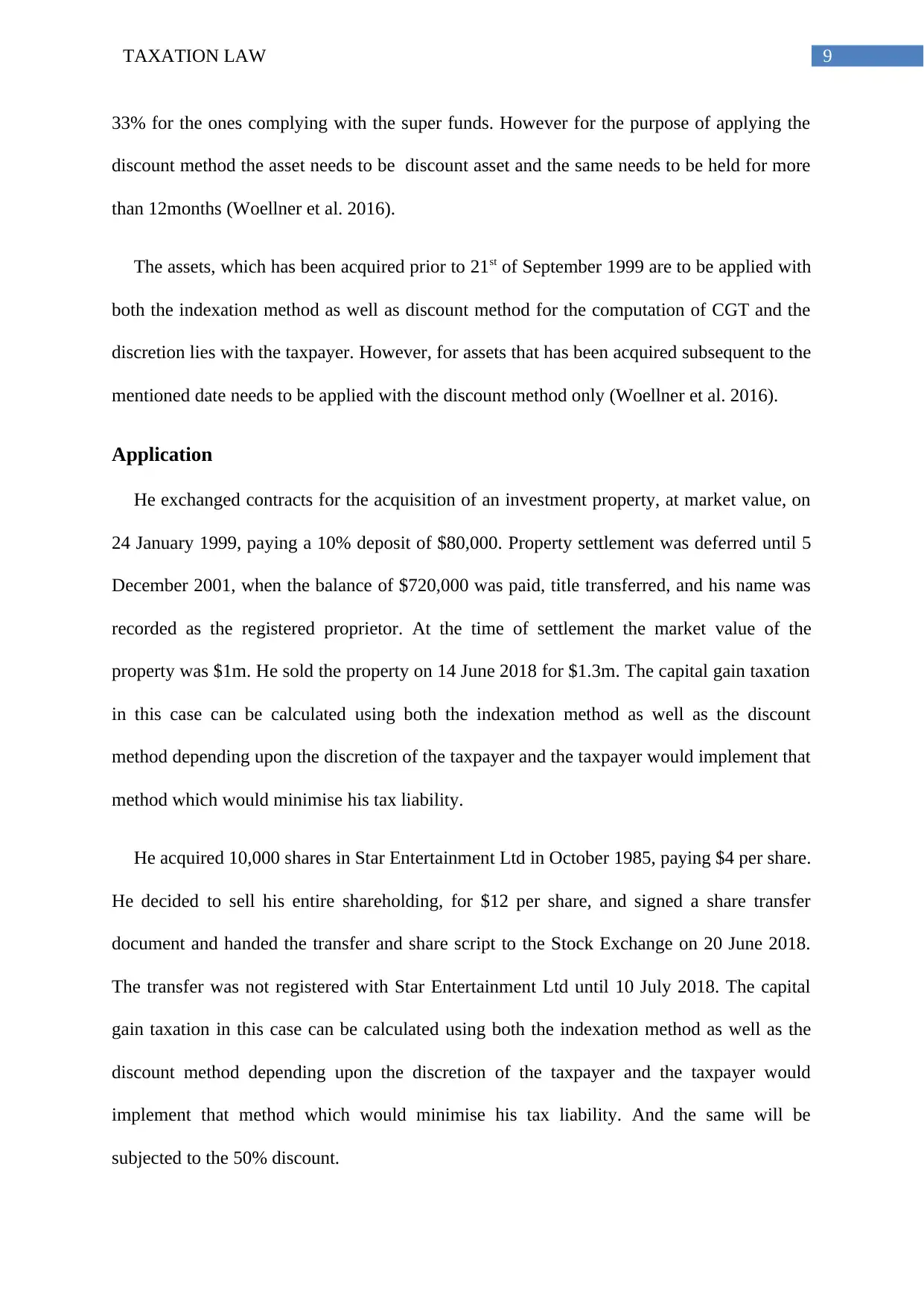
9TAXATION LAW
33% for the ones complying with the super funds. However for the purpose of applying the
discount method the asset needs to be discount asset and the same needs to be held for more
than 12months (Woellner et al. 2016).
The assets, which has been acquired prior to 21st of September 1999 are to be applied with
both the indexation method as well as discount method for the computation of CGT and the
discretion lies with the taxpayer. However, for assets that has been acquired subsequent to the
mentioned date needs to be applied with the discount method only (Woellner et al. 2016).
Application
He exchanged contracts for the acquisition of an investment property, at market value, on
24 January 1999, paying a 10% deposit of $80,000. Property settlement was deferred until 5
December 2001, when the balance of $720,000 was paid, title transferred, and his name was
recorded as the registered proprietor. At the time of settlement the market value of the
property was $1m. He sold the property on 14 June 2018 for $1.3m. The capital gain taxation
in this case can be calculated using both the indexation method as well as the discount
method depending upon the discretion of the taxpayer and the taxpayer would implement that
method which would minimise his tax liability.
He acquired 10,000 shares in Star Entertainment Ltd in October 1985, paying $4 per share.
He decided to sell his entire shareholding, for $12 per share, and signed a share transfer
document and handed the transfer and share script to the Stock Exchange on 20 June 2018.
The transfer was not registered with Star Entertainment Ltd until 10 July 2018. The capital
gain taxation in this case can be calculated using both the indexation method as well as the
discount method depending upon the discretion of the taxpayer and the taxpayer would
implement that method which would minimise his tax liability. And the same will be
subjected to the 50% discount.
33% for the ones complying with the super funds. However for the purpose of applying the
discount method the asset needs to be discount asset and the same needs to be held for more
than 12months (Woellner et al. 2016).
The assets, which has been acquired prior to 21st of September 1999 are to be applied with
both the indexation method as well as discount method for the computation of CGT and the
discretion lies with the taxpayer. However, for assets that has been acquired subsequent to the
mentioned date needs to be applied with the discount method only (Woellner et al. 2016).
Application
He exchanged contracts for the acquisition of an investment property, at market value, on
24 January 1999, paying a 10% deposit of $80,000. Property settlement was deferred until 5
December 2001, when the balance of $720,000 was paid, title transferred, and his name was
recorded as the registered proprietor. At the time of settlement the market value of the
property was $1m. He sold the property on 14 June 2018 for $1.3m. The capital gain taxation
in this case can be calculated using both the indexation method as well as the discount
method depending upon the discretion of the taxpayer and the taxpayer would implement that
method which would minimise his tax liability.
He acquired 10,000 shares in Star Entertainment Ltd in October 1985, paying $4 per share.
He decided to sell his entire shareholding, for $12 per share, and signed a share transfer
document and handed the transfer and share script to the Stock Exchange on 20 June 2018.
The transfer was not registered with Star Entertainment Ltd until 10 July 2018. The capital
gain taxation in this case can be calculated using both the indexation method as well as the
discount method depending upon the discretion of the taxpayer and the taxpayer would
implement that method which would minimise his tax liability. And the same will be
subjected to the 50% discount.
Secure Best Marks with AI Grader
Need help grading? Try our AI Grader for instant feedback on your assignments.
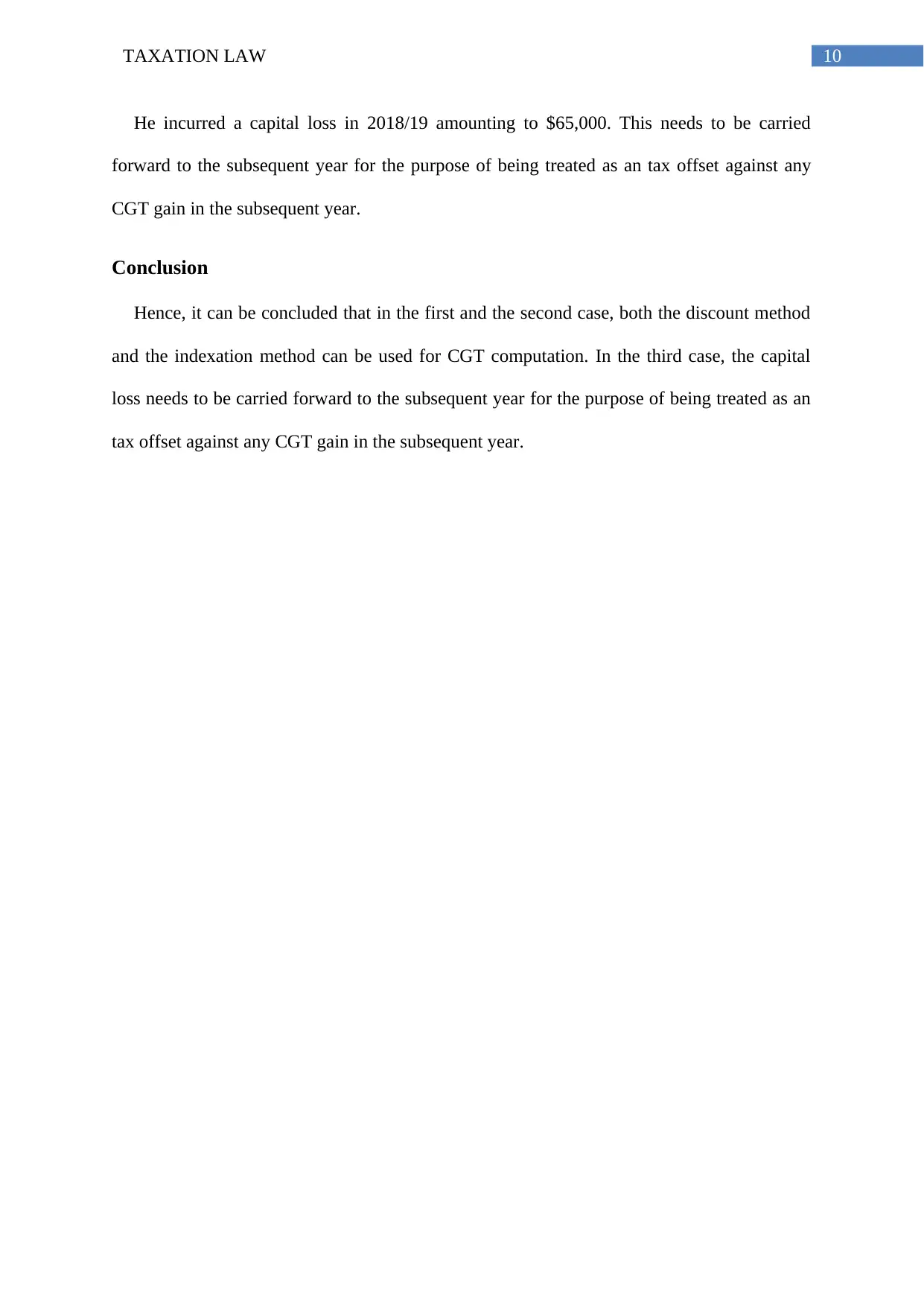
10TAXATION LAW
He incurred a capital loss in 2018/19 amounting to $65,000. This needs to be carried
forward to the subsequent year for the purpose of being treated as an tax offset against any
CGT gain in the subsequent year.
Conclusion
Hence, it can be concluded that in the first and the second case, both the discount method
and the indexation method can be used for CGT computation. In the third case, the capital
loss needs to be carried forward to the subsequent year for the purpose of being treated as an
tax offset against any CGT gain in the subsequent year.
He incurred a capital loss in 2018/19 amounting to $65,000. This needs to be carried
forward to the subsequent year for the purpose of being treated as an tax offset against any
CGT gain in the subsequent year.
Conclusion
Hence, it can be concluded that in the first and the second case, both the discount method
and the indexation method can be used for CGT computation. In the third case, the capital
loss needs to be carried forward to the subsequent year for the purpose of being treated as an
tax offset against any CGT gain in the subsequent year.
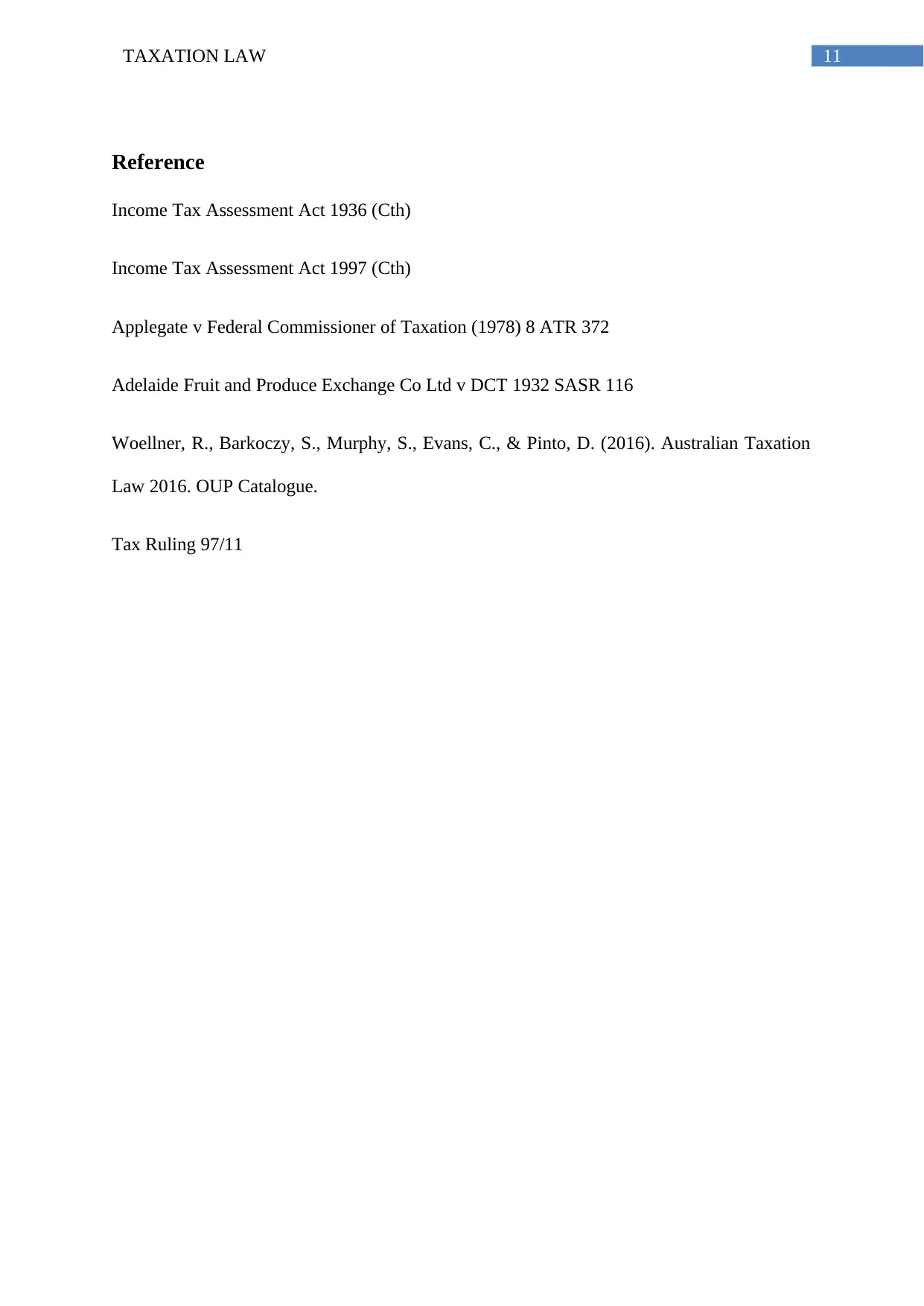
11TAXATION LAW
Reference
Income Tax Assessment Act 1936 (Cth)
Income Tax Assessment Act 1997 (Cth)
Applegate v Federal Commissioner of Taxation (1978) 8 ATR 372
Adelaide Fruit and Produce Exchange Co Ltd v DCT 1932 SASR 116
Woellner, R., Barkoczy, S., Murphy, S., Evans, C., & Pinto, D. (2016). Australian Taxation
Law 2016. OUP Catalogue.
Tax Ruling 97/11
Reference
Income Tax Assessment Act 1936 (Cth)
Income Tax Assessment Act 1997 (Cth)
Applegate v Federal Commissioner of Taxation (1978) 8 ATR 372
Adelaide Fruit and Produce Exchange Co Ltd v DCT 1932 SASR 116
Woellner, R., Barkoczy, S., Murphy, S., Evans, C., & Pinto, D. (2016). Australian Taxation
Law 2016. OUP Catalogue.
Tax Ruling 97/11
1 out of 12
Related Documents
Your All-in-One AI-Powered Toolkit for Academic Success.
+13062052269
info@desklib.com
Available 24*7 on WhatsApp / Email
![[object Object]](/_next/static/media/star-bottom.7253800d.svg)
Unlock your academic potential
© 2024 | Zucol Services PVT LTD | All rights reserved.



